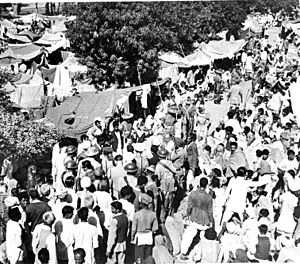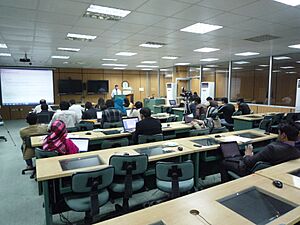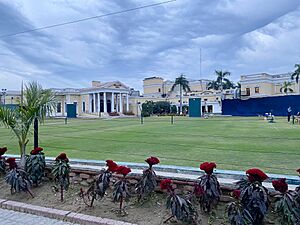Faisalabad facts for kids
Quick facts for kids
Faisalabad
فیصل آباد
|
|||
|---|---|---|---|
|
Metropolis
|
|||
|
Clock Tower
Lyallpur Gurdwara
Jhal Flyover
Circuit House Gardens
Faisalabad railway station
Lyallpur Galleria
|
|||
|
|||
| Nickname(s):
The Manchester of Pakistan
|
|||
|
Location in Punjab, Pakistan
|
|||
| Country | |||
| Province | |||
| Division | Faisalabad | ||
| District | Faisalabad | ||
| Settled | 1892 | ||
| Founded by | James Broadwood Lyall | ||
| Named for | Faisal of Saudi Arabia | ||
| Area | |||
| • City | 1,330 km2 (512 sq mi) | ||
| • Land | 840 km2 (325 sq mi) | ||
| • Water | 430 km2 (165 sq mi) 33% | ||
| • Metro | 5,860 km2 (2,261 sq mi) | ||
| Area rank | 3rd | ||
| Elevation | 186 m (610 ft) | ||
| Population
(2024)
|
|||
| • City | 3,800,193 | ||
| • Rank | 3rd, Pakistan | ||
| • Density | 2,865.7/km2 (7,422/sq mi) | ||
| Demonym(s) | Faisalabadi | ||
| Time zone | UTC+05:00 (PKT) | ||
| Postal code |
38000
|
||
| Area code(s) | 041 | ||
| Former Name | Lyallpur | ||
| Official Languages | Urdu, English | ||
| Native language | Punjabi | ||
| Languages (1981) | 98.2% Punjabi 1.8% Others |
||
| GDP | 10 billion (2024) | ||
Faisalabad, formerly known as Lyallpur, is a large city in the Punjab province of Pakistan. It is the second-largest city in Punjab and the third-most populated city in Pakistan. Faisalabad is a major industrial center, especially known for its textile industry. Because of this, it is often called the Manchester of Pakistan.
The city was planned and built in 1892. Its population grew very quickly after the Partition of India in 1947. Hundreds of thousands of Muslim immigrants from East Punjab settled here. Faisalabad is a key hub for industry and trade. It has good connections through roads, railways, and air travel.
Contents
What's in a Name?
Faisalabad was first called Lyallpur. It was named in 1890 after Sir James Broadwood Lyall. He was a British governor in Punjab who helped set up the city. The name Lyallpur means 'City of Lyall'.
In September 1977, the Government of Pakistan changed the city's name to "Faisalabad." This was done to honor King Faisal of Saudi Arabia. This change shows the strong friendship between Saudi Arabia and Pakistan.
A Look at Faisalabad's Past


How Faisalabad Started
The area where Faisalabad now stands was originally home to forest tribes. It was part of older regions like Jhang and Sandalbar. The city itself began to be settled in the 1880s. This was during a time when the British were setting up new farming areas.
The British government started a big project to bring water to dry lands in Punjab. This was done by building canals. The Chenab colony, which included Faisalabad, was the largest of these projects.
City Design and Growth
Popham Young, who managed the canal project, designed the city's center. It looks like the Union Jack, the flag of the United Kingdom. Eight roads spread out from a large clock tower in the middle. These roads became eight different markets, each leading to different parts of Punjab.
In 1892, the new town was connected to the British rail network. This helped transport its growing farm products. By 1911, the city had nearly 20,000 people. In the 1930s, Faisalabad grew with new industries. These included textile factories, food processing, and chemical plants.
After Independence
In August 1947, India and Pakistan became independent countries. British India was divided into two nations. This led to a huge movement of people. Many Hindus and Sikhs moved from Faisalabad to India. At the same time, Muslim refugees from India came to settle in Faisalabad.
In 1977, the city's name was changed from Lyallpur to Faisalabad. This honored King Faisal of Saudi Arabia for his support to Pakistan. In the 1980s, Faisalabad saw more foreign money invested in its textile industry. Many people from Faisalabad also started working abroad. This brought more money into the city, helping it grow and build new things.
Where is Faisalabad?
Faisalabad is located in the flat plains of northeast Punjab. It is about 186 meters above sea level. The city area is about 1326 square kilometers. The Chenab River flows about 30 kilometers away, and the Ravi River is about 40 kilometers to the southeast. Canals from the Chenab River provide water for most of the farms.
Faisalabad is surrounded by other cities. To the north are Chiniot and Sheikhupura. To the east are Sheikhupura and Sahiwal. To the south are Sahiwal and Toba Tek Singh. To the west is Jhang.
Faisalabad's Weather
Faisalabad has a mix of dry and humid weather. The weather is watched by the Pakistan Meteorological Department. They give forecasts and warnings, especially to farmers.
The city gets about 650 millimeters of rain each year. Most of this rain falls in July, August, and September during the monsoon season. Heavy monsoon rains can sometimes cause flooding. July is usually the wettest month. October and November are the driest months. In winter, it can be cloudy and foggy. The highest temperature ever recorded was 48.0 °C (118.4 °F) in June 1947 and May 2010. The lowest was -4.0 °C (24.8 °F) in January 1978.
Faisalabad's Culture
Faisalabad is a very diverse city. It is a big industrial center, so people from all over Pakistan come to live and work here. This mix of people creates a rich blend of traditions and customs.
Festivals and Celebrations
People in Punjab celebrate many cultural and religious festivals. Faisalabad celebrates Pakistan's Independence Day on August 14th each year. The city's markets are decorated, and buildings are lit up. Flag-raising ceremonies happen across the city.
In spring, there is an annual "Rang-e-Bahar" festival. This includes a flower show at Jinnah Gardens. The University of Agriculture also holds a similar event called "Kissan Mela." The "Canal Mela" is a five-day festival where the city's main canal is decorated with lights and floats.
As most people are Muslim, religious holidays like Ramadan, Eid al-Fitr, and Eid al-Adha are celebrated. The Prophet Muhammad's birthday, called Milad, is also observed. There are also Christian churches where Easter and Christmas services are held.
What People Wear
Traditional clothes in Faisalabad include the Kurta and Sherwani for men. Women wear white shalwar kameez with a dupatta (scarf). Some religious women wear burqas. People also mix Pakistani and Western styles. For example, women might wear an embroidered kurta with jeans. Men and women also wear modern Western clothes like dress pants, T-shirts, and jeans.
Some schools and universities have dress codes. For example, the National Textile University has rules to promote good values. These rules ban certain Western clothes like shorts for men and jeans or sleeveless shirts for women.
Delicious Food
Faisalabadi food is a mix of Punjabi cuisine, Mughlai cuisine, and Anglo-Indian cuisine. Common meals include rice or roti (flatbread) with a vegetable or meat curry. This is often served with a salad and yogurt. Sweet treats like gulab jamun and jalebi are also popular.
Street food is a big part of Faisalabadi cuisine. You can find Samosas (fried pastries with vegetables or meat) and gol gappay (fried balls filled with vegetables). Biryani and chicken pilao rice are also specialties.
A typical breakfast is halwa poori, which is a fried flatbread with spicy chickpea curry and sweet halwa. It's often enjoyed with lassi, a yogurt drink. In winter, people might have roghni naan with paya.
Seasonal drinks include rabri doodh (milky drink with nuts) and Kashmiri chai (pink milky tea) in winter. In summer, people drink sugarcane juice, iced lemon water, and iced orange drinks.
Learning in Faisalabad
Faisalabad has many places for learning and research. It is a regional center for higher education. It specializes in subjects like agriculture, medical sciences, and textile studies.
Many public schools and universities offer scholarships. This helps students from different backgrounds get an education. There are also many private schools and colleges with a wide range of courses.
How Education is Managed
The education system in Faisalabad is managed by the District Education Authority. The city government provides money, resources, and manages public schools. It works under the national Ministry of Federal Education.
Top Schools and Universities
Some of the well-known public institutions include:
- Faisalabad Medical University
- University of Agriculture
- Government College University Faisalabad
- Nuclear Institute for Agriculture and Biology
Private institutions include:
- National Textile University
- University of Faisalabad
- Beaconhouse School System
City Management
Faisalabad is managed by the city district government. It has seven main departments: Agriculture, Community Development, Education, Finance and Planning, Health, Municipal Services, and Works and Services. The head of the city government is the District Coordination Officer (DCO).
The city is divided into eight smaller areas called Tehsil Municipal Administrations (TMAs). These TMAs handle things like city planning, managing water and waste, and enforcing local laws. There are also 118 local councils called union councils. They collect information and help with local development plans.
The Faisalabad Development Authority (FDA) was set up in 1976. It plans and oversees major building projects in the city. It also works with the Water and Sanitation Agency (WASA) to manage water supply and drainage.
Public Services
Keeping the City Safe
Law enforcement in Faisalabad is handled by the Punjab Police. The city police officer (CPO) leads the police force in Faisalabad.
The City Traffic Police in Faisalabad manages traffic. They ensure road safety, put up signs, and issue driving licenses.
The District and Sessions Court handles legal cases in Faisalabad.
Taxes and Fees
The Regional Tax Office collects federal taxes for the Federal Board of Revenue (FBR). This office helps people understand taxes and makes sure businesses follow tax laws.
The Excise, Taxation and Narcotics Control Department is a provincial government department. It collects property tax, registers vehicles, and manages certain regulated substances.
Water and Cleanliness
The Water and Sanitation Agency (WASA) provides water and sewerage services to the city. WASA gets most of its water from wells near the Chenab River. They work to improve water supply and drainage in Faisalabad.
Healthcare in Faisalabad
Faisalabad has several large public hospitals. Allied Hospital Faisalabad is the biggest public hospital in the city. It offers many advanced treatments.
Other government hospitals include DHQ (District Headquarter) Hospital, Institute of Child Care, and PINUM Cancer Hospital.
Media and Communication
TV and Radio
The Pakistan Electronic Media Regulatory Authority (PEMRA) oversees TV and radio in Pakistan. Pakistan Television Corporation is the state-owned TV network. Private TV channels have been allowed since 2002.
Radio Pakistan started broadcasting in Faisalabad in 1982. It now has three FM stations: FM101, FM93, and FM93.4 Sautul Qur'an Channel.
Phones and Internet
The Pakistan Telecommunication Authority manages phone and internet services. Pakistan Telecommunication Company Limited is a major provider of phone and internet services. Many other companies also offer mobile and internet services in the city.
Movies and Theater
In 2008, the government allowed Bollywood films to be shown in cinemas again. This led to new cinemas opening in Faisalabad. Universities also encourage students to create plays and workshops. These help share ideas about peace and understanding.
Fun Things to Do
Parks and Green Spaces
The Parks and Horticulture Authority (PHA) manages all public parks in Faisalabad.
- Jinnah Gardens is the oldest and most important park. It's also known as "Company Bagh."
- Dhobi Ghat Park is a historic park where many important speeches and rallies have taken place.
- Gatwala Park is on the edge of the city. It's a family park with a zoo and a lake. The Gatwala Wildlife Park is a nature reserve nearby.
- Pahari Grounds has a retired Pakistan Air Force F-86 Sabre jet on display.
- D-Ground Park is in a shopping area. It features models of Pakistani monuments.
Sports
Cricket is very popular in Faisalabad. International cricket matches are held at Iqbal Stadium. This stadium is home to the local team, the Faisalabad Wolves.
The Faisalabad Hockey Stadium was built in 2002. It can hold 25,000 people and is the third-largest field hockey stadium in Pakistan.
Libraries and Museums
There are two public libraries in Faisalabad:
- Allama Iqbal Library is in a colonial building from 1911. It was originally called "Coronation Library."
- Municipal Corporation Public Library is in Iqbal Park. It has many books and a photo gallery.
The Lyallpur Museum is next to the Allama Iqbal Library. It is a heritage museum with art, old items, and photos about the region's history.
Social Clubs
The Chenab Club, founded in 1910, is the oldest social club in Faisalabad. It was started by British soldiers. Today, it offers sports, dining, and cultural activities.
Getting Around Faisalabad
Airport
Faisalabad International Airport is about 15 kilometers from the city center. It had major upgrades between 2014 and 2017. It serves both local and international flights. Airlines like Pakistan International Airlines and FlyDubai operate here. The airport also handles cargo and has a military base.
Trains
The Faisalabad railway station is the main train station. Train services are run by Pakistan Railways. There are cargo and express parcel services that connect Faisalabad to other parts of the country.
Roads
Faisalabad has a very good road network. It is connected to other cities by the M4 motorway and other highways.
Partner Cities
Faisalabad is known worldwide for its textile exports. It has "sister city" relationships with several cities around the globe:
 Qingdao, China
Qingdao, China Wuhan, China
Wuhan, China Tabriz, Iran
Tabriz, Iran Kanpur, India
Kanpur, India Kobe, Japan
Kobe, Japan Cordoba, Spain
Cordoba, Spain Sharjah, United Arab Emirates
Sharjah, United Arab Emirates Manchester, United Kingdom
Manchester, United Kingdom Los Angeles, United States of America
Los Angeles, United States of America
See also
 In Spanish: Faisalabad para niños
In Spanish: Faisalabad para niños

























